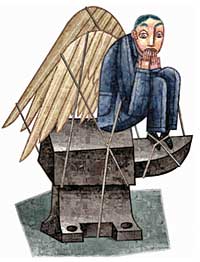At the end of the 19th century, Lord Kelvin, one of the world’s greatest physicists and president of The Royal Society, was asked if machines might fly. No, he replied, only balloons could fly. “Heavier-than-air flying machines are impossible,” he said. Yet several years later, the Wright brothers flew. Today we all do.
Heinrich Hertz, the German physicist who was the first person to send and receive radio waves, didn’t think there would be much use for his discovery. Radio waves traveled only a few feet, he said, and getting them to go farther seemed impossible. But not long after Hertz made his pronouncement, Guglielmo Marconi sent radio waves across the Atlantic. Today,
|
|
we continue to find new uses for them—cell phones, GPS, Bluetooth, Wi-Fi and, of course, RFID.
In both cases, these renowned physicists made categorical, negative predictions based on the laws of physics. And in both instances, innovators proved them wrong. The moral of these stories: We know the laws of physics but not the limits of innovation. Whatever the dire predictions of scientists, someone, somewhere, will find a way to do “the impossible.”
Nevertheless, “experts” claim that the laws of physics prevent further advancements in RFID—from longer read ranges to higher read rates and cheaper tags. These doom-mongers cite physics with resounding finality, as if anyone who argues with them is naive. It’s true that the laws of physics don’t change. But it’s just as true that the laws of physics do not predict what technology can achieve.
The discipline that best predicts the future is history. And history gives us hope: Technology has always improved. Inventors have always
found a way. There’s no reason to think RFID will be any different.
In fact, there’s already evidence that RFID is just as susceptible to surprising performance leaps through innovation as every other major technology has been. In 2002, engineers at the Auto-ID Center at MIT were challenged to read a pallet of metallic products, and even they, optimists and inventors all, were skeptical. But within a week, they had solved the problem by bouncing radio waves through air gaps in the pallet, like light diffracting through a crystal. Similarly, in 1999, six feet of read range from a UHF tag seemed like an upper limit to almost everyone, including me. Yet a few years later, RFID vendors demonstrated more than 20 feet of read range. Today, no self-respecting EPC Gen 2 proponent would expect anything less.
People who say the laws of physics are the reason something can’t be done are saying only that they don’t know how to do it. Some things are doubtless impossible, but we’re a long way from finding out what they are. History also shows that innovation takes a little longer than optimists expect. We will not see every problem solved this year, and the technology will never be perfect. But we can be sure that by this time next year, RFID’s capabilities will have changed, while the laws of physics will have stayed exactly the same.
So as we begin this New Year when the first RFID mandates take effect, I offer some advice from history: Never take physics for an answer. Instead, trust in humanity’s imagination, ingenuity and, above all, hope.
Kevin Ashton was cofounder and executive director of the Auto-ID Center. He is the author of a soon-to-be-published book about RFID. To comment on this story, click on the link below.



